What to Do When Your Dogs Paws Are Raw
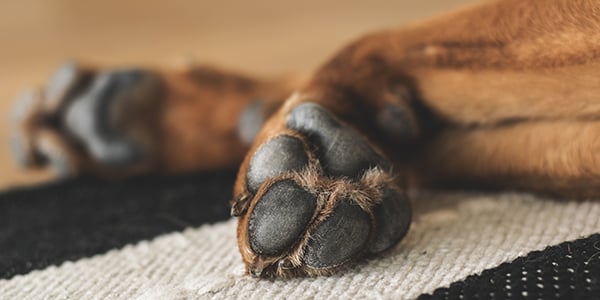 Let's talk about paw pads! Foot care is just as important for our dogs as it is for us humans — dogs can suffer from blisters or torn paw pads, burnt paws from walking on pavement that's too hot, or mats between their toes. Ouch!
Let's talk about paw pads! Foot care is just as important for our dogs as it is for us humans — dogs can suffer from blisters or torn paw pads, burnt paws from walking on pavement that's too hot, or mats between their toes. Ouch!
Injured paw pads make walking painful and can get infected, and mats between their toes can cause walking problems or a variety of skin issues if your dog licks at them. It's important to properly care for your dog's feet beyond making sure their nails are trimmed, and it's pretty simple!
What Exactly Are Paw Pads?
Paw pads consist of a layer of pigmented skin, usually pink or black, covering fatty tissue. Since fat is insulating, these give your pup's paws a bit of protection from colder surfaces in the winter. They're also an integral part of your dog's foot structure and work in conjunction with your dog's nails (which provide protection for the pads). Paw pads help with your dog's balance, and provide traction, stability, and shock absorption, too.
You might notice that your dog's paw pads are rough and calloused or smooth and soft — this all depends on the terrain your dog regularly walks on. If you take your dog hiking often, or they take regular walks out on asphalt, they'll have more calloused paw pads due to the exposure to rougher terrain. If your dog is older and doesn't walk as much, or spends most of their outside time running around on grass, their paw pads are likely to be smoother (and more likely to tear when they do walk on rougher surfaces).
Just as we humans can build up calluses by incremental exposure to rough surfaces, you can do the same with your dog if you plan on frequent hikes or know they'll be walking on rougher surfaces throughout their life. Start with shorter periods of time on these surfaces to let the pad build up toughness over time.
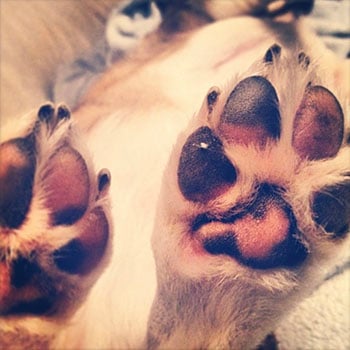 Paw Pad Maintenance and Care
Paw Pad Maintenance and Care
Make it a habit to check your dog's paw pads regularly. Gently spread their toes apart and inspect the sides of their paw pads and between their toes for any injuries or foreign objects (like burrs, pebbles, or dangerous foxtails). It's also a good time to check for any swelling or discoloration. Watch to see if your dog shows any signs that they are in pain or have tenderness when examining their foot.
Avoid Walking Your Dog on Hot Pavement
Hot pavement or asphalt can burn your dog's paw pads. You can easily check to see if the ground is too hot for your dog to walk on by placing the back of your hand flat on the pavement and try holding it there for 7 seconds. If it's too hot for you to keep it there for the full time, it's too hot for your dog to walk on! If the pavement is that hot, it's probably too hot for a dog walk or other outdoor activities.
Keep your dog's potty walks during hot weather short, try to walk your dog on grass and in the shade, and have lots of cool, fresh water available for frequent rehydration.

How to Care for Your Dog's Paws in Winter
Winter can also be tough on your dog's paw pads, with snow, ice, and salt. No ice-melt product is completely safe for your dog and many can cause your dog's paw pads to dry out, crack, or even burn, and can be toxic if your dog ingests it by licking it off their paws. Try to avoid walking them on salt-treated sidewalks if possible. Click here to learn more about which ice melters are safer for your pet if you need to de-ice your driveway or sidewalk.
- Keep your dog's paw pads trimmed of excess fur between their toes. This way they won't collect paw "snowballs" between their toes as easily. These snowballs form when snow and ice get wrapped up in dog fur, melt from their body heat, and then refreeze. Snowballs on your dog's feet and legs can cause a lot of pain and discomfort since they are pushing your dog's toes apart and pulling on the hair. See below for our cordless trimmer suggestion, one that many groomers use.
- Have your dog wear booties outside during the winter. Or, if they don't tolerate boots, apply paw wax prior to going outside in the snow or ice. Check out my top picks for dog boots, including disposable options, further below.
- Wash and dry your dog's paws after any trip outside – especially if they've been walking on salt-treated surfaces. If your dog's paws have collected snowballs, use some paw wax to slide the ice out from between their toes before washing with warm water. A portable paw washer, like the Dexas Mudbuster, can give you a quick and easy way to wash off your pup's paws with less mess!
Dexas Mudbuster Portable Dog Paw Washer
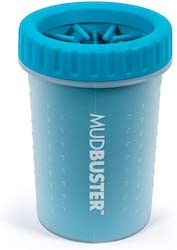
Protect Your Dog's Paws with Paw Wax
An easy way to protect your dog's paws is to use paw pad waxes, which are a great option if your dog doesn't tolerate wearing booties or you can't find one that stays on. Paw pad wax, like Musher's Secret (originally created for working sled dogs), is easy to apply and moisturizes their paw pad, creating a barrier around your dog's foot that repels ice, salt, dirt, and helps protect your dog's paw pad from burns. Think of it as an invisible boot! Apply to their paws just before heading outside.
Musher's Secret Paw Protection Wax
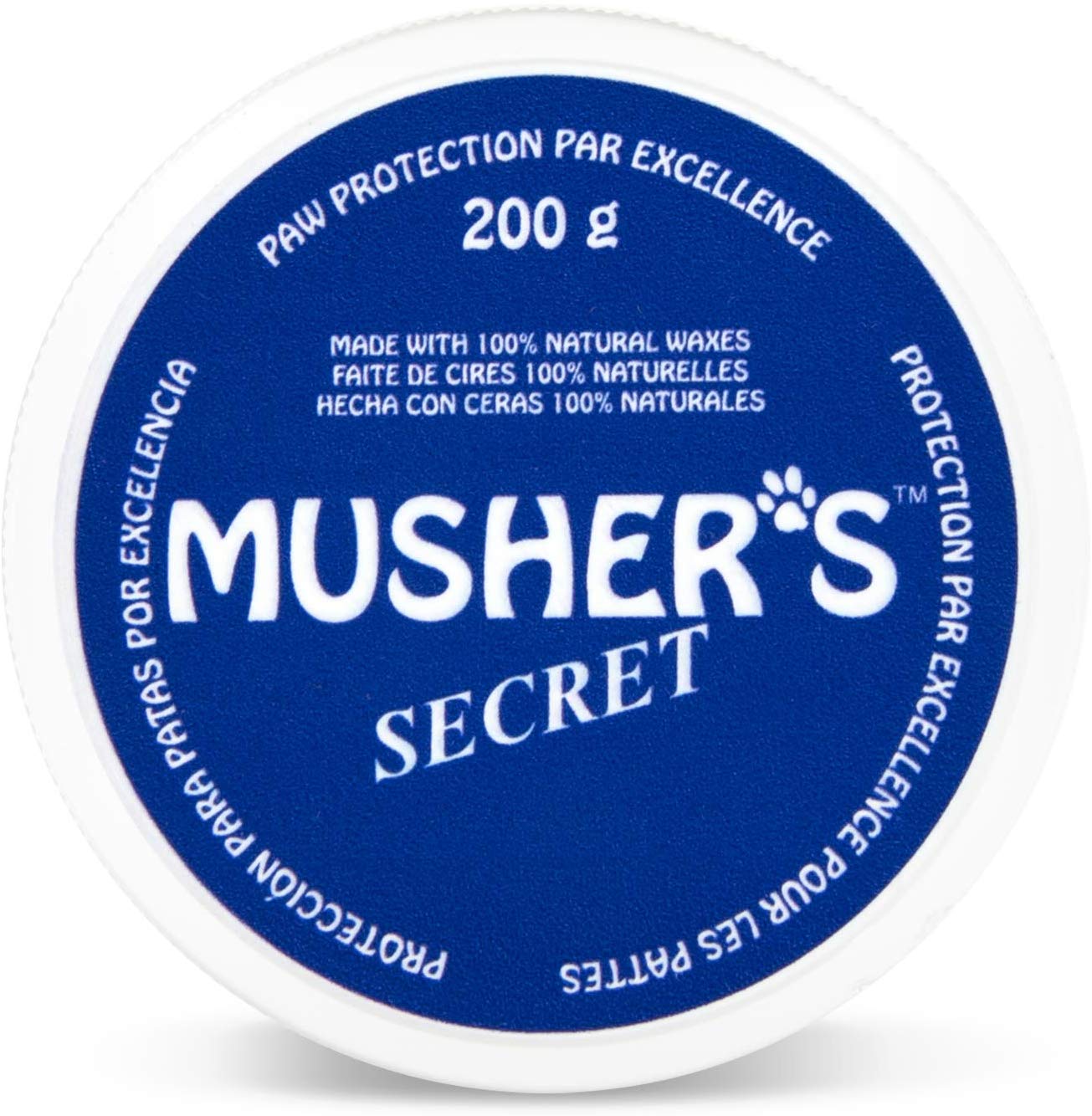

Should You Moisturize Your Dog's Paws?
You should moisturize your dog's paw pads if they are cracked, peeling, or too dry. Avoid using human lotions or moisturizers and stick with products made specifically for canine paws. Be careful not to overdo it — if your dog already has soft paw pads, moisturizing them can make them more susceptible to tearing or ripping when they walk on rough surfaces.
Keeping Your Dog's Paw Pads Trimmed and Mat-Free
Keeping the fur or hair that grows between your dog's paw pads nice and short can also help to keep their feet healthy and provide more traction on slippery surfaces. Traction is especially important for senior dogs! Combine trimming your aging dog's paw pads regularly with putting out mats or carpets so they can get around your home with less slipping.
When their paw pads are trimmed it's easier for you to inspect and clean their paws, and keeps ice build-up out from between their toes during snowy weather. It also helps to prevent any matting between your dog's toes, which can be painful and cause your dog to chew at their feet (which leads to hot spots and other skin issues). Some dogs don't have much fur growing on the bottom of their feet, but medium to thick-coated dogs tend to have fuzzy feet that can benefit from trimming.
It's easy to trim your dog's paw pads at home using grooming clippers! I personally recommend the Wahl Bravura clippers for paw pad trims (and even sanitary – aka "poop chute" – trims if your dog needs them). Because it's cordless, it's easy to use and has a 5-in-1 blade with different length options. The #10 length setting is the best length for paw pad trims.
Wahl Bravura Cordless Grooming Clippers

Watch Preventive Vet's office dog Finnegan (a Portuguese Water Dog with incredibly fluffy feet) get his paws trimmed at home with the Wahl Bravura in this video:
Check out this video from Love of Grooming to see a groomer explain the holding and scooping technique:
Pro Tip: Preventing mats is much better than having to shave and trim them out! The easiest way to prevent matting is to keep their coat thoroughly brushed.
If you have a breed or breed mix whose coat is prone to matting and tangling, make sure to brush out their legs, feet, and between their toes frequently — especially after getting wet! Moisture causes a dog's coat to curl and twist around itself, which results in mats galore if it isn't brushed out while drying.
Toe Tangles and Mats
If you notice that your dog has a mat between their toes or between their paw pads, you can try using olive oil to loosen the mat, or if your dog allows it, try gently combing it out. Often a dog will not tolerate having a foot mat combed out, as it can be extremely painful. I recommend having a professional groomer help you with any matting on your dog's feet*.
*Grooming Safety Warning: Scissors can cause injury to your dog during grooming. Do not use scissors to try and trim paw pads or trim out mats unless you are properly trained in these grooming techniques, have the proper tools, and feel comfortable doing so. Dogs can be very sensitive about their feet and might be extra wiggly when you're holding their paws. Using scissors instead of clippers to trim out any matting often results in injury. If that happens you'll need to go to the veterinarian for treatment and medication to prevent infection (which can be costly), plus your dog will be much less willing to be handled the next time. It's oftentimes easier and safer to leave mat trimming to the professionals.
Protect Your Dog's Paws with Dog Boots
A paw pad injury can be very painful for your dog, whether it's from ripping a paw pad during excessive running and play, cutting a pad while on a hike, ice build-up between their pads, or burning and blistering from walking on hot surfaces. The best way to protect your dog's paw pads from wear and tear is to have your dog wear booties when they are participating in activities or in environments that could damage their pads. Look for a sturdy, well-fitted, and non-slip boot for your pup.
These PawZ dog boots are great disposable dog booties that provide protection against hot pavement, rain, snow, environmental allergies and provide traction for senior pets. They are available in a variety of sizes (there's even a "tiny" size for teacup breeds or puppy feet!) and in packs of 12. Each boot can be reused multiple times before tossing.
PawZ Rubber Dog Boots
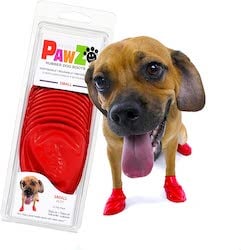
PRO TIP: Many senior dogs wear these PawZ boots for extra traction around the home. To allow for airflow around the paw pad, simply use a hole puncher to punch one or two holes in the bottom of the bootie. While this does take away the waterproof feature of the boots, it allows for longer indoor wear without stinky or sweaty paws.
Ultra Paws Rugged Dog Boots
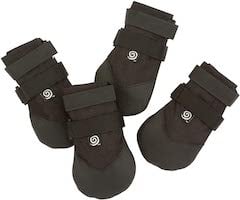
These rugged dog boots are easy to size and introduce to your pup because of their lightweight and soft material.
Muttluks Snow Mushers Winter Dog Boots
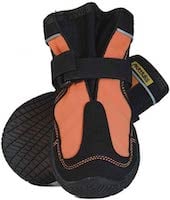
Keep your dog's paws toasty warm in these Muttluks! Specifically made for cold weather and snowy climates, these are a great choice for winter with their fleece lining and rubber soles.
Kurgo Blaze Cross Dog Boots
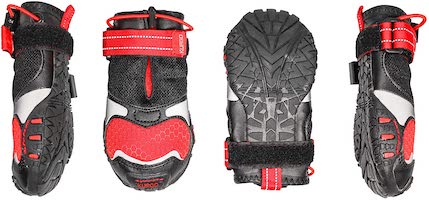
Live in a rainy climate? These lightweight boots are water-resistant and provide lots of traction with non-slip soles.
How to Help Your Dog Get Used to Wearing Boots
It's always a good idea to introduce booties slowly with some desensitization techniques to help your dog feel less stressed by their new kicks and more comfortable moving about in them.
Watch this video to see how easy it is to teach your dog to love wearing their boots:
Common Dog Paw Issues
Smelly Paws
Dog paws can smell for a variety of reasons. They have sweat glands in their paw pads that help them cool down in hot weather, and they have scent glands as well that let them leave behind their pheromones so others knew they were there (which is why many dogs scrape their feet on the grass or kick the dirt after going to the bathroom).
More commonly, people complain (and others find it oddly comforting) that their dog's feet smell like corn chips. This smell is from bacteria or yeast on your dog's feet, usually between their toes and paw pads. Yeast and bacteria on your dog's feet is normal, and your dog's immune system works to keep them at a manageable number. However, if you're noticing that your dog's paws really reek of Fritos, visit your veterinarian to find out the cause and treat the infection. Sometimes these infections are caused by food or environmental allergies. Make sure to thoroughly wipe and dry off your dog's paws after they take a trip outside to help prevent an overload of yeast and bacteria between their toes.
Hyperkeratosis
Do your dog's paw pads look rough, thick, or crusty? Does it look like they've got fur growing from their paw pads? This is called canine hyperkeratosis, and you might see it on their paw pads or on their nose. Hyperkeratosis can be genetic or the result of an underlying medical condition, so it's important you speak with your vet if you notice it. In the meantime, you can keep your dog's paws moisturized and protected with paw pad balm to reduce your dog's discomfort.
What to Do When Your Dogs Paws Are Raw
Source: https://www.preventivevet.com/dogs/how-to-properly-care-for-your-dogs-paw-pads
0 Response to "What to Do When Your Dogs Paws Are Raw"
Post a Comment